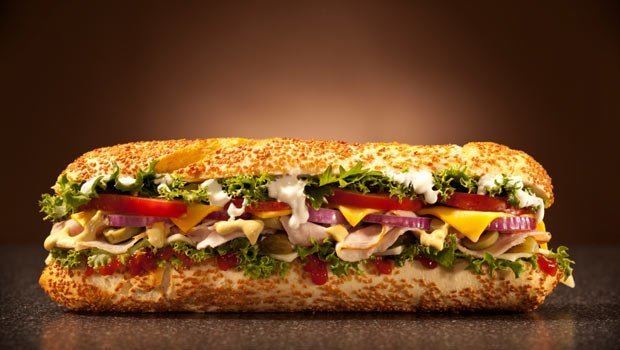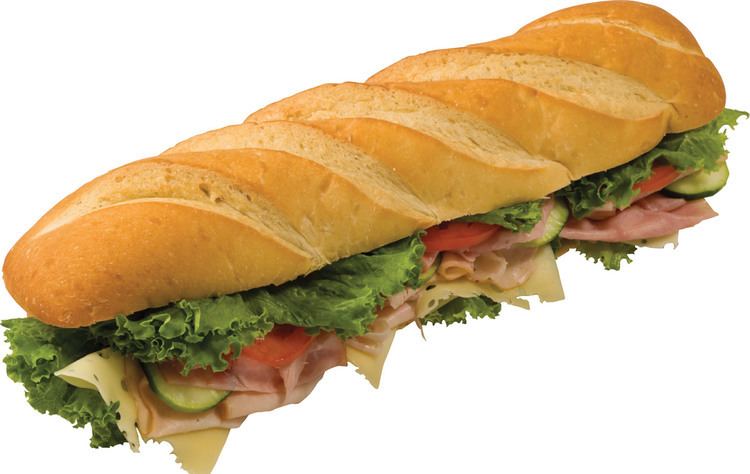Alternative names Multiple Region or state Northeast Variations Multiple | Place of origin United States Main ingredients Multiple | |
 | ||
Similar Sandwich, Cheesesteak, Wrap, Provolone, Ranch dressing | ||
Submarine sandwich by pes
A submarine sandwich, also known as a sub, wedge, hoagie, hero, grinder, or Italian sandwich, is a type of sandwich that consists of a length of bread or roll split lengthwise and filled with a variety of meats, cheeses, vegetables, and condiments. The sandwich has no standardized name, with over a dozen regional variations used across the U.S. Larger submarine sandwiches, particularly those that are longer in length or overstuffed with greater quantities of ingredients than usual, are sometimes called battleship sandwiches or destroyer sandwiches.
Contents
- Submarine sandwich by pes
- Italian submarine sandwich video 173
- History and etymology
- Submarine
- Hoagie
- Hero
- Grinder
- Wedge
- Other types
- Popularity and availability
- References

The terms submarine and sub are widespread and not assignable to any certain region, though many of the localized terms are clustered in the northeastern United States.
Italian submarine sandwich video 173
History and etymology
The Italian sandwich originated in several different Italian American communities in the Northeastern United States from the late 19th to mid-20th centuries. Portland, Maine claims to be the birthplace of the Italian sandwich and it is considered Maine's signature sandwich. The popularity of this Italian-American cuisine has grown from its origins in Connecticut, Pennsylvania, Delaware, Maryland, New York, New Jersey, and Massachusetts, and Rhode Island to most parts of the United States, Canada, and with the advent of chain restaurants, is now available in many parts of the world.

In British English the type of bread roll used is known as a baton, baguette or French stick, and despite the burgeoning success of the Subway franchise chain, the American usage has not become widespread in the UK.
Submarine
The use of the term "submarine" or "sub" (after the resemblance of the roll to the shape of a submarine) is widespread. While some accounts source the name as originating in New London, Connecticut (site of the United States Navy's primary submarine base) during World War II, written advertisements from 1940 in Wilmington, Delaware indicate the term originated prior to the United States' entry into World War II.

One theory says the submarine was brought to the U.S. by Dominic Conti (1874–1954), an Italian immigrant who came to New York in the early 1900s. He is said to have named it after seeing the recovered 1901 submarine called Fenian Ram in the Paterson Museum of New Jersey in 1928. His granddaughter has stated the following: "My grandfather came to this country circa 1895 from Montella, Italy. Around 1910, he started his grocery store, called Dominic Conti's Grocery Store, on Mill Street in Paterson, New Jersey where he was selling the traditional Italian sandwiches. His sandwiches were made from a recipe he brought with him from Italy, which consisted of a long crust roll, filled with cold cuts, topped with lettuce, tomatoes, peppers, onions, oil, vinegar, Italian herbs and spices, salt, and pepper. The sandwich started with a layer of cheese and ended with a layer of cheese (this was so the bread wouldn't get soggy)."
Hoagie
The term hoagie originated in the Philadelphia area. The Philadelphia Bulletin reported, in 1953, that Italians working at the World War I–era shipyard in Philadelphia known as Hog Island, where emergency shipping was produced for the war effort, introduced the sandwich by putting various meats, cheeses, and lettuce between two slices of bread. This became known as the "Hog Island" sandwich; shortened to "Hoggies", then the "hoagie".
The Philadelphia Almanac and Citizen's Manual offers a different explanation, that the sandwich was created by early-twentieth-century street vendors called "hokey-pokey men", who sold antipasto salad, meats, cookies and buns with a cut in it. When Gilbert and Sullivan's operetta H.M.S. Pinafore opened in Philadelphia in 1879, bakeries produced a long loaf called the pinafore. Entrepreneurial "hokey-pokey men" sliced the loaf in half, stuffed it with antipasto salad, and sold the world's first "hoagie".
Another explanation is that the word "hoagie" arose in the late 19th to early 20th century, among the Italian community in South Philadelphia, when "on the hoke" was a slang term used to describe a destitute person. Deli owners would give away scraps of cheeses and meats in an Italian bread-roll known as a "hokie", but the Italian immigrants pronounced it "hoagie".
Shortly after World War II, there were numerous varieties of the term in use throughout Philadelphia. By the 1940s, the spellings "hoagie" and, to a lesser extent, "hoagy" had come to dominate less used variations like "hoogie" and "hoggie". By 1955, restaurants throughout the area were using the term "hoagie". Listings in Pittsburgh show hoagies arriving in 1961 and becoming widespread in that city by 1966.
Former Philadelphia mayor (and later Pennsylvania governor) Ed Rendell declared the hoagie the "Official Sandwich of Philadelphia". However, there are claims that the hoagie was actually a product of nearby Chester, Pennsylvania. DiCostanza's in Boothwyn, Pennsylvania claims that the mother of DiConstanza's owner originated the hoagie in 1925 in Chester. DiCostanza relates the story that a customer came into the family deli and through an exchange matching the customer's requests and the deli's offerings, the hoagie was created.
Woolworth's to-go sandwich was called a hoagie in all U.S. stores.
Bánh mì sandwiches are sometimes referred to as "Vietnamese hoagies" in Philadelphia.
Hero
The New York term hero is first attested in 1937. The name is sometimes credited to the New York Herald Tribune food writer Clementine Paddleford in the 1930s, but there is no good evidence for this. It is also sometimes claimed that it is related to the gyro, but this is unlikely as the gyro was unknown in the United States until the 1960s, according to some sources.
"Hero" (plural usually heros, not heroes) remains the prevailing New York City term for most sandwiches on an oblong roll with a generally Italian flavor, in addition to the original described above. Pizzeria menus often include eggplant parmigiana, chicken parmigiana, and meatball heros, each served with sauce.
Grinder
A common term in New England, its origin has several possibilities. One theory has the name coming from Italian-American slang for a dock worker, among whom the sandwich was popular. Others say it was called a grinder because it took a lot of chewing to eat the hard crust of the bread used.
In Pennsylvania, New York, Delaware, and parts of New England the term grinder usually refers to a hot submarine sandwich (meatball; sausage; etc.), whereas a cold sandwich (e.g., cold cuts) is usually just simply called a "sub".
Wedge
The term "wedge" is used in Westchester County, New York, Putnam County, New York, and Fairfield County, Connecticut—three counties directly north of New York City.
Some base the name "wedge" on a diagonal cut in the middle of the sandwich, creating two halves or "wedges", or a "wedge" cut out of the top half of the bread with the fillings "wedged" in between, or a sandwich that is served between two "wedges" of bread. It has also been said "wedge" is just short for "sandwich"; with the name having originated from an Italian deli owner located in Yonkers, who got tired of saying the whole word.
Other types
Popularity and availability
From its origins with the Italian American labor force in the Northeastern United States, the sub began to show up on menus of local pizzerias. As time went on and popularity grew, small restaurants, called hoagie shops and sub shops, that specialized in the sandwich began to open.
Pizzerias may have been among the first Italian-American eateries, but even at the turn of the [20th] century distinctions were clear-cut as to what constituted a true ristorante. To be merely a pizza-maker was to be at the bottom of the culinary and social scale; so many pizzeria owners began offering other dishes, including the hero sandwich (also, depending on the region of the United States, called a 'wedge,' a 'hoagie,' a 'sub,' or a 'grinder') made on a Italian loaf of bread with lots of salami, cheese, and peppers.
By the late 20th century, due to the rise of large franchisee chain restaurants and fast food, the sandwich became available worldwide. Many outlets offer non-traditional ingredient combinations.
In the United States, many chain restaurants have arisen that specialize in subs including Capriotti's, Submarina, Jersey Mike's Subs, Charley's Grilled Subs, Blimpie, Jimmy John's, Lenny's Sub Shop, Milio's Sandwiches, Port of Subs, Eegee's, Firehouse Subs, Penn Station, Planet Sub, Potbelly, Togo's, Tubby's, Which Wich? and D'Angelo Sandwich Shops. Major international chains include Quiznos, Mr. Sub and the largest restaurant chain in the world, Subway. The sandwich is also often available at supermarkets and convenience stores.
